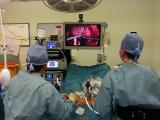The problem with prostate cancer is in knowing whether you have an aggressive form of the cancer and therefore require a surgical option, or if you have a less agressive form of the disease - which is more likely. The aggressiveness of prostate cancer can now be measured using a genomic test called Prolaris. The Prolaris test measures a key feature of cancer growth, namely 'cell proliferation', and whether the genes for cancer cell proliferation are 'expressed'. 
Eight out of ten men diagnosed with prostate cancer will now survive for longer than five years. So, the aim is to preserve maximum quality of life by selecting the most appropriate prostate cancer treatment from a range of options. The most important factor relies on the aggressiveness of the disease (which varies widely from patient to patient). However, until recently it has been difficult to diagnose this factor. Most men would naturally prefer to avoid the risks of surgery if possible or to keep surgery to a minimum, and radical prostatectomy is not always necessary. The new genomic test now facilitates and helps to provide the information required to make these types of decisions.
For further information on assessing surgical treatment options see - Prostate Cancer Pre-operative Staging by Consultant Urologist Mr Christian Brown.
Prolaris and Risk Stratification
The challenge for managing clinically localised prostate cancer effectively is to first of all establish the level of cancer aggression especially as cell proliferation rates vary widely from patient to patient. The new prostate cancer proliferation test provides an accurate indication of the level of threat.










